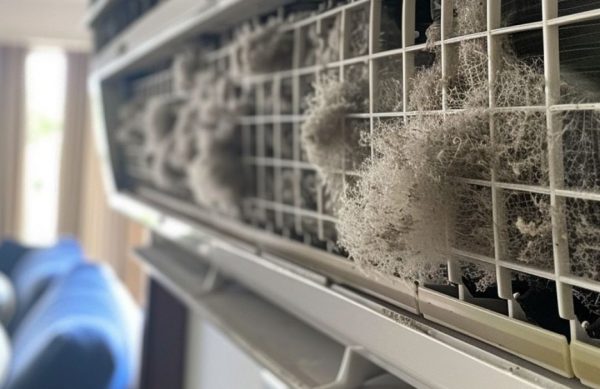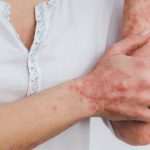Whenever I am a couple of weeks late changing the HEPA filters in my ionizers, they become especially filthy. They come out covered in a black, grimy fuzz and are thoroughly disgusting.
Where the heck does this stuff come from?
In my case, it’s probably because I live in a flight path. Every day when I walk outside, my white car is covered in soot from jet fuel. I assume it gets in my house too. That would explain the condition of those filters.
The scary part is that, without my filters, this crap would be going into my lungs. And that certainly wouldn’t be good.
There are all kinds if things like this around the house that we forget to think about.
Your air conditioning or heating units, for example.
Filters for these systems help keep dust from building up in the ductwork and blowing into your home. That dust could contain mold spores, bacteria, pet dander and pollen that could severely affect your health.
When all of that stuff blows out of the vent, it gets into your carpet, bed, pillows, upholstered furniture, drapes – everywhere!
So it’s important to keep your filters changed on a regular basis. In fact, I’ve even added a special UV light filter to the air handler of my A/C unit to clean the air before it goes into the ductwork. This works double-duty to keep mold, bacteria, germs and odors out of my home.
The same concept applies to water filters. All sorts of contaminants build up in them. If you don’t change them on schedule, they’ll become a breeding ground for mold and bacteria.
Once a filter hits maximum capacity, all of that stuff will end up leaking into the water that comes out of your faucet. So you should be especially vigilant about changing your water filter on schedule.
And speaking of water…
Water and Humidity are #1 Sources of Mold
Down here in South Florida, mold can be a big problem. Anyone who lives in an area that’s consistently hot and humid can have problems with mold. But that doesn’t mean it can’t infiltrate homes in other climates.
Leaking pipes, leaking roofs, a build-up of condensation in the house, poor ventilation, wet clothing, a damp basement… there are all kinds of ways water can get into your home and cause mold growth.
Mold can make itself at home almost anywhere in your house. The carpet, ceiling, drywall, carpet, upholstery and anyplace that is dark and moist.
The problem with mold is the spores it produces. They float around in the air and you breathe them in. They can trigger allergies, breathing issues, sinus infections, bronchitis and other health issues.
If any area in your home has a damp, moldy smell, look for water stains or fuzzy growths. The basement, kitchen and bathroom are prime areas for mold growth. It can also grow under your carpet or furniture. (Mildewy carpets, furniture or other moldy household items may need to be thrown away and replaced.)
In the meantime, be sure to fix any leaks or plumbing problems as soon as you discover them.
Once you’ve repaired the issue, put a little elbow grease into scrubbing away any mold on hard surfaces with a natural cleaning product and water. Or, you can fizzle the mold away with hydrogen peroxide and a little less scrubbing activity.
Be aware, however, that hydrogen peroxide can act as a bleaching agent, so avoid using it on fabrics.
After you’ve cleared the mold and fixed any leaks or other water problems, continue to monitor the areas and remember to dry down damp areas – like sinks and showers – after each use.
The Problem with Cockroach Contaminants
One thing that really disgusts me are cockroaches.
The first cockroach allergy was reported in 1943, when certain people had skin rashes immediately after a cockroach crawled over their skin. Isn’t that disgusting?
And it’s not just live roaches that cause this reaction. When researchers exposed certain people to the dead body parts of cockroaches, they developed skin rashes, too. And who knows how many dead cockroaches are in your attic or A/C ducts?
Cockroach allergens are also a risk factor for the development of asthma; and aggravate asthma symptoms in people who already have the condition. In fact, between 60% and 80% of children with asthma who live in densely populated cities are sensitive to cockroach allergens.
These filthy bugs have been implicated in the spread of all kinds of bacteria, including E. coli and salmonella, along with a number of parasitic worms and other human pathogens. If they are crawling on your pots, pans, silverware and other dishes, they can spread around bacteria that can cause food poisoning, diarrhea, and other gastrointestinal-related issues.
Cockroaches like to be near food and water, so once they get into your home they can thrive, especially in the kitchen and bathroom.
With this in mind, keep your sinks, tables, counters and floors clean of food and liquids. Wash the dishes after eating and scrub down the kitchen sink every evening after its last use. Give your cabinets and drawers a good cleaning every couple of months. And always store food in airtight containers, including pet food.
I also recommend sealing and caulking any gaps between the walls, doors and window seals, and replace worn-out weather stripping to help keep roaches from getting into your home in the first place.
If you have areas where you know roaches are lurking, you can get some of those “roach motels.” Or, for a more natural solution, mix a little sugar in a small lid or cap with some baking soda or borax. When they feed on this sugar mixture, the added ingredient effectively kills them.
These are some simple things you can monitor to help you stay healthier and breathe easier in your home.
SOURCES:
Fisk WJ, Eliseeva EA, Mendell MJ. Association of residential dampness and mold with respiratory tract infections and bronchitis: a meta-analysis. Environ Health. 2010;9:72.
Bernton HS, Brown H. Insect allergy–preliminary studies of the cockroach. J Allergy. 1964 Nov-Dec;35:506-13.
Sohn MH, Kim KE. The cockroach and allergic diseases. Allergy Asthma Immunol Res. 2012;4(5):264-269.
Do DC, Zhao Y, Gao P. Cockroach allergen exposure and risk of asthma. Allergy. 2016;71(4):463-474.
Donkor ES. Cockroaches and Food-borne Pathogens. Environ Health Insights. 2020;14:1178630220913365.






